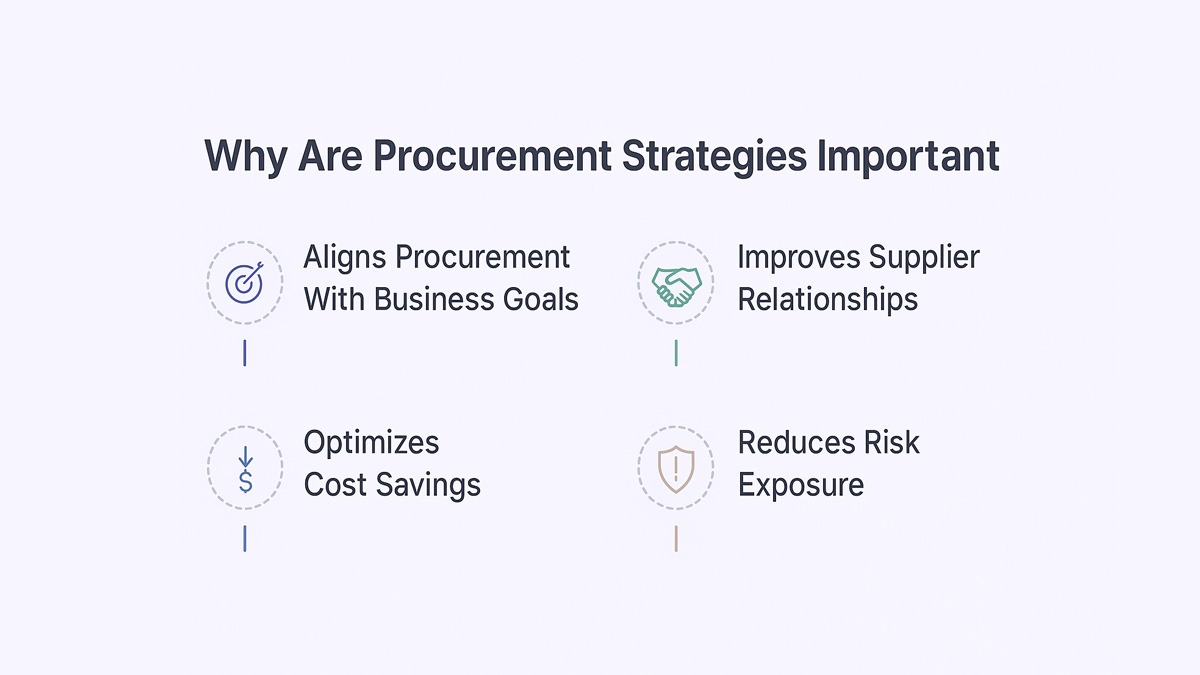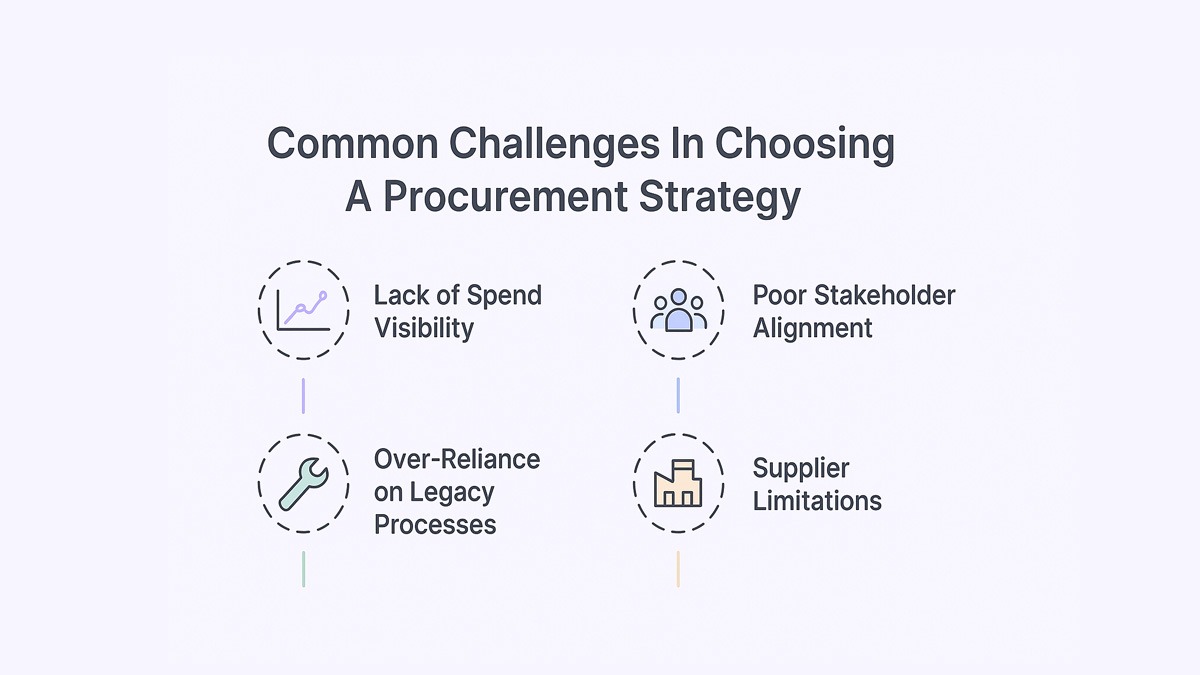

6 Procurement Strategies That Could Save (Or Sink) Your Bottom Line

6 Procurement Strategies That Could Save (Or Sink) Your Bottom Line
Learn six essential procurement strategies and how to use them to reduce costs, manage risks, and improve vendor outcomes.


Procurement might seem like a back-office function, but the strategies behind it often shape the entire financial health of a business. Whether you’re scaling fast, managing a global supply chain, or tightening margins during an economic downturn - your approach to procurement can mean the difference between major savings and costly inefficiencies. The right strategy doesn’t just cut costs. It can sharpen your competitive edge.
What are Procurement Strategies?
Procurement strategies are structured approaches businesses use to source goods or services effectively. They align purchasing goals with broader business objectives, helping organizations manage supplier relationships, control costs, and reduce risks across the supply chain. Effective procurement strategies also play a vital role in strengthening your overall supply chain management framework.
Why are Procurement Strategies Important?
Procurement strategies help businesses gain control over spending, reduce waste, and strengthen supplier relationships. They’re essential for turning procurement from a cost center into a value driver.
By identifying and eliminating unnecessary expenses, procurement strategies also support long-term cost avoidance. Here are the reasons why procurement strategies matter:

1. Aligns Procurement With Business Goals
A clear procurement strategy connects every purchase decision with overarching business goals. Whether you’re prioritizing growth, cost-efficiency, or innovation, strategic procurement ensures resources are allocated in ways that support long-term outcomes.
2. Improves Supplier Relationships
Strong procurement strategies promote better collaboration with vendors. By setting clear expectations and aligning on mutual goals, companies can foster long-term partnerships that lead to better pricing, reliable delivery, and even innovation.
3. Optimizes Cost Savings
When procurement is strategic, businesses can negotiate better deals, eliminate redundancies, and identify cost-saving opportunities across the supplier base. It’s not just about finding cheaper options - it’s about finding smarter ones. This is where procurement optimization adds value by improving efficiency and supplier performance simultaneously.
4. Reduces Risk Exposure
Every purchase comes with a degree of risk - supply chain disruptions, non-compliance, or vendor failures. A defined strategy includes risk mitigation tactics, like supplier diversification and contract safeguards, to prevent minor issues from snowballing.
6 Types Of Procurement Strategies Explained
Procurement isn’t a one-size-fits-all game. Different business models, industries, and growth stages require different approaches. Choosing the right strategy can improve margins, reduce disruptions, and even unlock competitive advantages.
Here are six commonly used procurement strategies - and when it makes sense to use them:
1. Cost-Based Procurement Strategy
This strategy focuses on getting the best price possible. Tracking procurement-related Key Performance Indicators can help measure the real impact of this cost-driven approach. Businesses prioritize suppliers offering the lowest total cost of ownership - including purchase price, shipping, storage, and maintenance.
When to use this: Ideal in highly competitive industries where cost control is critical, such as retail or manufacturing.
Key considerations:
- Don’t sacrifice quality for savings - evaluate value, not just price
- Conduct regular benchmarking to compare supplier pricing
- Watch out for hidden long-term costs like poor after-sales service
- Bundle purchases to gain volume-based discounts
2. Risk Management Procurement Strategy
This strategy is all about minimizing exposure to potential disruptions - whether from geopolitical issues, supplier failure, or natural disasters. Companies often turn to Supply Chain Consulting partners to design more resilient sourcing strategies. It involves diversifying vendors, building redundancy, and planning for worst-case scenarios.
When to use this: Best for global companies or industries with sensitive supply chains like healthcare or electronics.
Key considerations:
- Identify critical suppliers and map risk exposure
- Maintain a pool of backup vendors for essential products
- Review contracts to include risk-transfer clauses
- Invest in tools for supply chain monitoring and early warnings
3. Green Procurement Strategy
Sustainability meets sourcing. Green procurement emphasizes working with eco-conscious suppliers, reducing carbon footprints, and choosing products with lower environmental impact - even if they cost more upfront.
When to use this: When ESG goals are part of your company’s mission or required by regulations.
Key considerations:
- Look for suppliers with certifications (e.g., ISO 14001)
- Evaluate lifecycle costs instead of upfront prices
- Align with internal sustainability and reporting frameworks
- Build ESG into vendor scorecards and evaluations
4. Just-In-Time (JIT) Procurement Strategy
This strategy reduces inventory costs by sourcing items only when needed. It keeps capital free and storage costs low - but requires airtight coordination. This makes it a key strategy for businesses looking to improve inventory management without compromising on availability.
When to use this: Works best in stable environments with predictable demand, like automotive or electronics assembly.
Key considerations:
- Choose reliable suppliers with fast lead times
- Tighten communication between procurement and production
- Build strong data infrastructure to avoid timing mismatches
- Maintain contingency plans for last-minute delays
5. Vendor Development Strategy
Instead of constantly switching suppliers, this strategy focuses on building long-term relationships. The buyer invests in improving the supplier’s capabilities - helping them scale, meet compliance, or reduce costs.
When to use this: Ideal when vendors provide mission-critical services or lack maturity.
Key considerations:
- Set mutual performance improvement targets
- Offer training or technical support when needed
- Create structured feedback loops to track progress
- Ensure incentives are aligned for both parties
6. Volume Aggregation Strategy
Buy more, pay less. This strategy involves consolidating purchases - either across departments, locations, or business units - to negotiate better terms and unlock economies of scale.
When to use this: Best for multi-location businesses or those using the same suppliers across teams.
Key considerations:
- Audit current contracts to identify overlaps
- Aligning these contracts with clearly defined spend policies can ensure consistency across departments
- Standardize specifications across teams
- Use centralized procurement tools to manage spend visibility
- Monitor consumption trends to plan aggregated orders effectively
- Implementing category management can also help standardize supplier selection and improve contract negotiations
When To Use Each Procurement Strategy
Choosing the right procurement strategy isn’t just about preference - it’s about context. What works for a lean startup might backfire for a multinational enterprise. Each strategy shines under different circumstances, and knowing when to apply them can be the difference between efficiency and chaos.
For example, if your business is scaling rapidly and needs predictable input flow, a vendor development strategy helps build stable partnerships. On the flip side, if you’re tightening budgets in a downturn, cost-based procurement can help stretch every dollar.
JIT works beautifully when demand is stable, but could unravel in volatile markets. Green procurement might be a must for ESG-focused organizations or those facing regulatory pressure.
In short, think of procurement strategies as tools in a kit - use the right one for the job at hand.
Common Challenges In Choosing A Procurement Strategy
Selecting a procurement strategy isn’t always straightforward. Companies often encounter barriers - some obvious, others hidden beneath day-to-day operations. Here are four common roadblocks that get in the way:

1. Lack of Spend Visibility
You can’t fix what you can’t see. Accurate and timely spend data is crucial for identifying savings opportunities and reducing rogue spend. Without a clear picture of where money’s going, what’s being bought, and who’s buying it, even the best procurement strategy will struggle to take root.
2. Over-Reliance on Legacy Processes
Many teams stick with outdated workflows simply because “it’s how we’ve always done it.” This inertia prevents innovation and slows down transformation - even when there’s a clear case for change. Embracing digital transformation in procurement workflows can help overcome these legacy bottlenecks.
3. Poor Stakeholder Alignment
If procurement, finance, and operations aren’t on the same page, strategy falls apart. Misaligned goals lead to fragmented execution and conflicting priorities. In such cases, Procurement Outsourcing can provide the expertise and capacity needed to bridge internal gaps.
4. Supplier Limitations
Sometimes the strategy fits, but the suppliers don’t. A lack of mature or capable vendors can make it hard to implement advanced strategies like JIT or green procurement.
How Spendflo Helps With Procurement Strategy Optimization
Choosing the right procurement strategy is just the beginning - executing it effectively is where the real work begins. That’s where Spendflo steps in. With a centralized platform tailored for fast-growing businesses, Spendflo helps finance and procurement teams gain complete visibility into software spending, vendor performance, and renewal cycles.
Whether you’re aggregating spend across teams, negotiating better deals, or identifying shadow IT, Spendflo provides the data and tools you need to make procurement strategic - not reactive.
This also helps eliminate reliance on manual accounting methods that often slow down procurement visibility. Plus, with expert-backed negotiation support and automated workflows, you can execute any procurement strategy faster, smarter, and with measurable ROI.
Frequently Asked Questions on Types of Procurement Strategies
What are the most effective procurement strategies for cost reduction?
Cost-based and volume aggregation strategies are typically the most effective for cutting expenses. They focus on negotiating better deals, consolidating purchases, and reducing unnecessary spending through improved vendor terms.
How do I know which procurement strategy suits my business?
The right strategy depends on your business size, industry, supply chain complexity, and goals. Start by evaluating current spending patterns, risk exposure, and growth plans. Then choose a strategy - or combination - that aligns with those needs.
Can I combine multiple procurement strategies?
Absolutely. Many companies blend strategies based on different categories or business units. For instance, a company might use cost-based procurement for office supplies while using vendor development for mission-critical software.
What is spend analysis, and why is it important in procurement?
Spend analysis helps businesses gain visibility into where their money is going. By breaking down procurement data, companies can identify savings opportunities, eliminate inefficiencies, and negotiate better deals with suppliers - making it a critical foundation for any strategic procurement initiative.
How do procurement KPIs improve decision-making?
Procurement KPIs (Key Performance Indicators) offer measurable insights into efficiency, cost savings, and supplier performance. They help teams track progress, identify bottlenecks, and make data-driven decisions that align with broader business goals. When done right, these KPIs can reveal friction points throughout the procurement cycle and enable targeted improvements.
What is a purchase requisition, and how does it differ from a purchase order?
A purchase requisition is an internal document used to request a purchase, while a purchase order is sent externally to suppliers. Requisitions kickstart the procurement process and ensure that all purchases are pre-approved before moving forward.










.png)




.png)










.avif)





